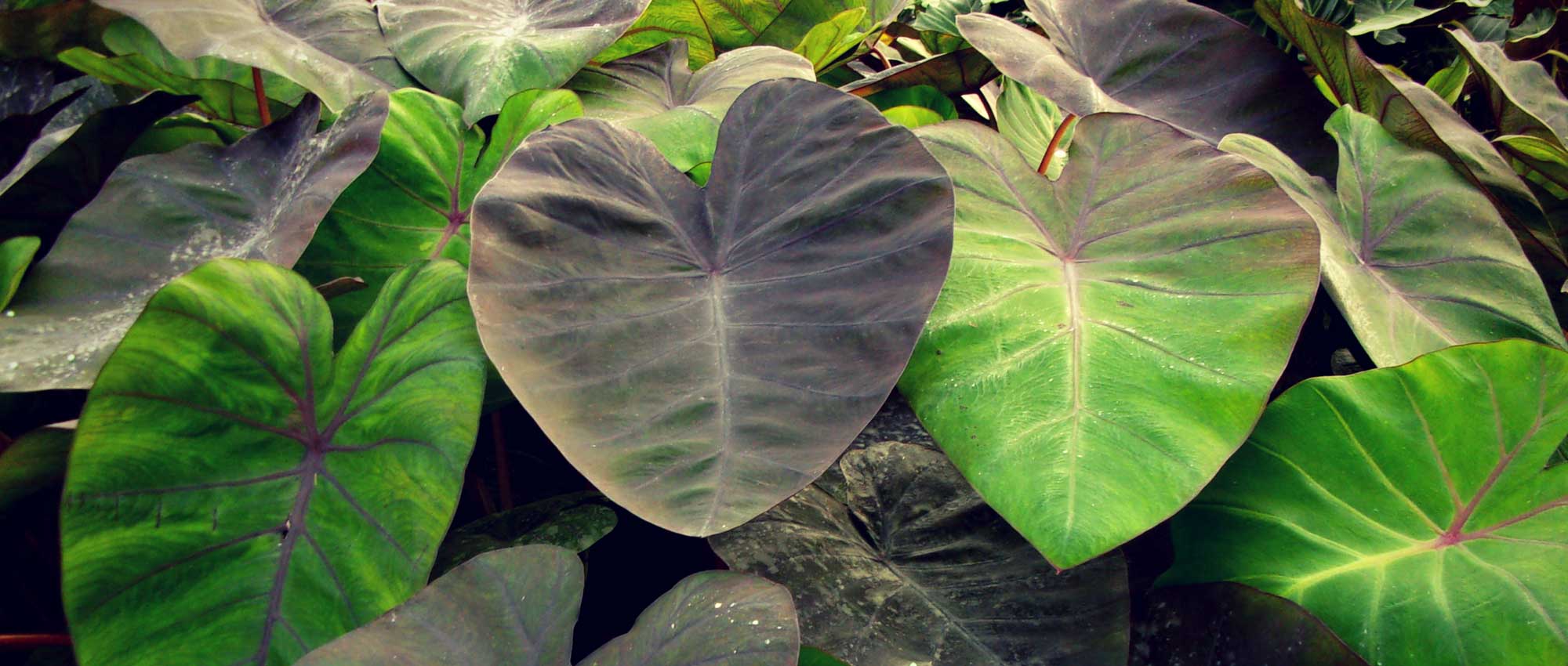
Colocasia: planting, growing and care
Contents
Colocasia in a nutshell
- Colocasia offers lush and spectacular foliage, often in very beautiful shades
- It is perfect for adding an exotic style to gardens and terraces
- It is a hardy and vigorous plant that grows quickly!
- Enjoying moist soils, it is ideal for greening the banks of a pond
- It can be planted in a pot and grown indoors
- Although it is a tropical plant, some varieties are surprisingly hardy, tolerating temperatures as low as -15°C!
A word from our Expert
Also known as Elephant Ear, Taro, or Caribbean Cabbage, colocasia is an exotic plant that impresses us with its large and majestic foliage, often featuring stunning hues. Although in some parts of the world it is primarily cultivated for its edible tuber once cooked, in the garden, colocasias are appreciated for the exotic and lush appearance they bring. Their leaves can be green, black, variegated, with veins often very pronounced in a different hue. Discover colocasia ‘Black Magic’, with very dark foliage, ‘Pink China’, with pink petioles, or Colocasia gigantea, of very large stature! These plants add volume and quickly become a focal point in a border.
Colocasia is a robust and vigorous plant, with rapid growth. It enjoys warmth and humidity, and will thrive on the banks of a pond, or in another location where the soil is moist. It is important to avoid letting the soil dry out! It can be planted directly in the garden, or grown in a pot and brought indoors if necessary for winter. It also adapts well to indoor or warm greenhouse cultivation! As for maintenance, colocasia needs to be watered in summer, fertilised occasionally, and possibly protected in winter.
Botany
Botanical data
- Latin name Colocasia sp.
- Family Araceae
- Common name Colocasia, Taro, Elephant Ear, Caribbean Cabbage...
- Flowering infrequent
- Height between 70 cm and 2.50 m
- Exposure preferably semi-shade
- Soil type moist, rich
- Hardiness variable. Quite tender, but some varieties can withstand down to -10 / -15 °C.
The colocasia is a herbaceous perennial plant whose enormous leaves give it an exotic appearance. There are eight species known. The most common is the Colocasia esculenta, or Taro, often cultivated for its edible tuber once cooked. The colocasia originates from the humid tropical regions of East Asia (Malaysia, Myanmar…). It grows naturally in wet meadows, on the banks of ponds or waterways… which explains its preference for cool soils, and it thrives at the edge of a pond. Similarly, as they come from tropical regions, colocasias are generally quite tender… with the exception of a few varieties, such as ‘Pink China’ which can withstand down to -15 °C. Hybridization has led to the creation of numerous varieties with original foliage, variegated, veined, and sometimes with coloured petioles.
The colocasia is classified among the Araceae, a family that includes over 3,000 plants native to tropical and subtropical areas… Including the most common houseplants: Monstera, Philodendron, Epipremnum aureum (Pothos), Dieffenbachia, Zamioculcas… The Araceae often have very surprising flowers, such as those of Amorphophallus, Arisaema or Dracunculus… These plants are also distinguished by their impressive foliage, very green but sometimes with beautiful nuances. The colocasia closely resembles alocasia and xanthosoma, two genera with which it is very closely related, leading to some confusion.
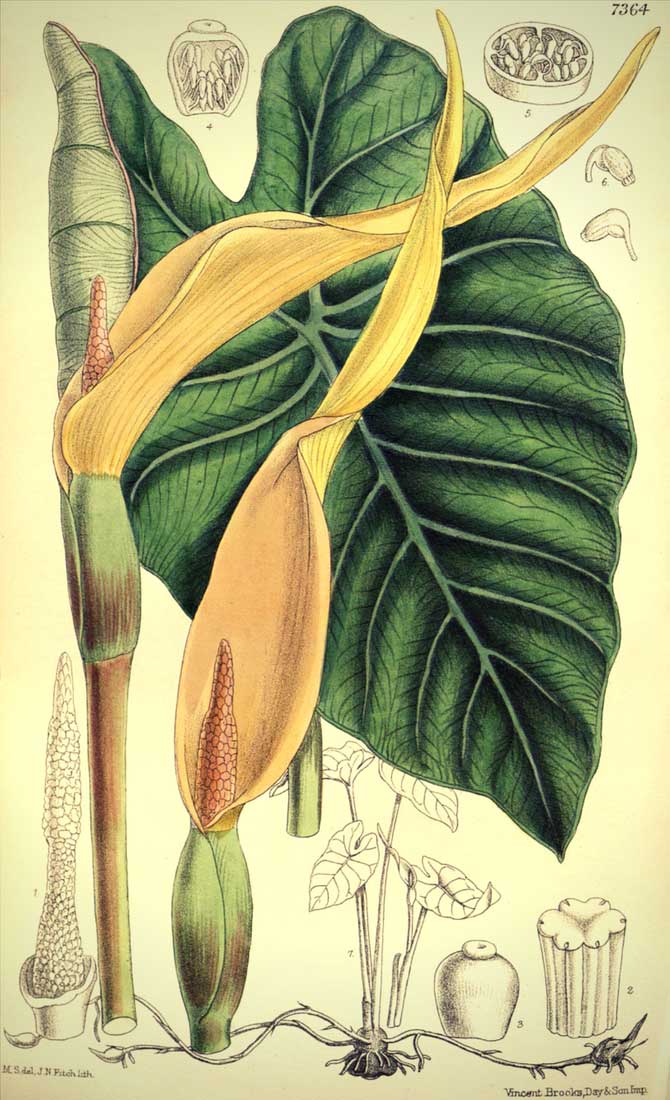
Colocasia esculenta: botanical illustration
The colocasia has many different common names: Taro, Elephant Ear, Caribbean Cabbage, Chinese Cabbage, Madeira… The name Elephant Ear is more specifically reserved for the Alocasia macrorrhiza, alluding to its giant leaves, while Taro more specifically refers to the Colocasia esculenta. In Latin, the species name, esculenta, means edible.
Colocasias are large plants that measure between 70 cm and 2.50 m… and even up to 3 m tall in the case of Colocasia gigantea ‘Thailand Giant Strain’! There are some smaller varieties, better suited for small gardens, such as Colocasia ‘Madeira’, which does not exceed 90 cm in height. Colocasias have a really fast growth rate, forming a clump of large leaves borne on long petioles.
The colocasia particularly captivates us with its exceptional foliage, which offers a beautiful diversity of shades! Its leaves come in a wide range of greens: from bright yellow-green to dark green, often slightly bluish. They can also be purplish, and sometimes almost black (‘Black Magic’)… The shades are stunning in the colocasia ‘Blue Hawai’; they take on rich nuances of green, yellow, and blue.
The veins, as well as the edge of the lamina, are generally very pronounced, with a different colour (often light green, brighter than the rest of the lamina), creating patterns, as seen in ‘Emerald’ or ‘Imperial Gigante’. Some varieties have a very surprising variegated effect, such as Colocasia ‘Mojito’!
The leaves are heart-shaped (cordate), or even slightly sagittate (arrow-shaped). They are quite thick, leathery, and measure between 60-80 cm long and 50-60 cm wide… But can reach up to 1.50 m in length in the largest varieties. The edge of the lamina is slightly undulate. The leaves are sometimes a bit plicate, as seen in Colocasia gigantea or Colocasia ‘Black Stem’. They are inclined towards the ground, unlike alocasia which often have leaves upright towards the sky.

The foliage of colocasias! From left to right, the varieties ‘Black Magic’, ‘Imperial Gigante’, ‘Mojito’ and ‘Pink China’
When water droplets fall on the leaves of the colocasia, they bead up, not spreading but retaining a spherical shape, similar to that of the lotus. They do not adhere to the surface but glide over it, taking with them dust and dirt. The leaf surface is said to be hydrophobic.
The leaves are attached to the clump by a long and thick petiole, measuring up to 1 m in length. It is sheathing, meaning it wraps around the base of the other petioles. It sometimes takes on beautiful colours! It is pink in the variety ‘Pink China’, and boasts a beautiful black hue in the variety ‘Black Stem’, providing a lovely contrast with the lighter leaf.
The foliage is evergreen in a warm climate, but deciduous when temperatures are cool (in this case, the aerial parts disappear but the plant remains underground, in dormancy, in the form of a tuber). This therefore depends on your cultivation method, whether you keep it outdoors, under a veranda, or in a warm greenhouse… The temperature must be at least 15 or 20°C for the foliage to persist in winter.
The colocasia has rhizomes (underground stems), which swell and form tubers (storage organs), making its propagation easier. The tubers of taro, Colocasia esculenta, are edible when cooked. The colocasia also has the particularity of producing stolons.

The flowering of Colocasia esculenta (photo Dinesh Valke) and the tubers (photo Forest & Kim Starr)
It is quite rare for the colocasia to flower when cultivated in our gardens. When we are fortunate enough to see it, we can observe a very characteristic flowering of the Araceae, which appears in summer, around August and September. The flowers are tiny and grouped on a spike (spadix), enveloped by a bract (spathe), just like in Arums. The female flowers are located at the base of the spike, and the male flowers at the upper part of it. The inflorescences have a pale cream-yellow hue and a funnel shape. They are located in the axil of the leaves, between the petioles.
The fruits of the colocasia are small berries that appear on the lower part of the floral spike, once it has faded.
The main varieties of colocasia
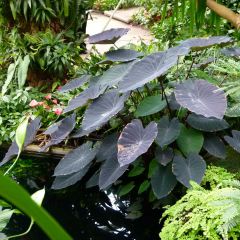
Colocasia esculenta Black magic
- Flowering time August, September
- Height at maturity 1,60 m
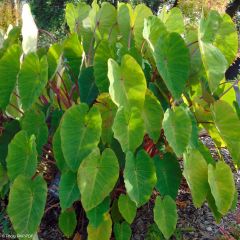
Colocasia Pink China
- Flowering time June to November
- Height at maturity 1,25 m
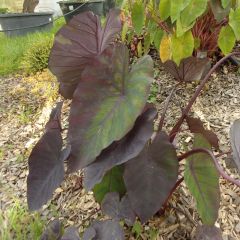
Colocasia Madeira
- Flowering time August, September
- Height at maturity 90 cm
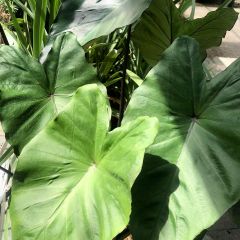
Colocasia esculenta Black Stem
- Flowering time July, August
- Height at maturity 1,80 m
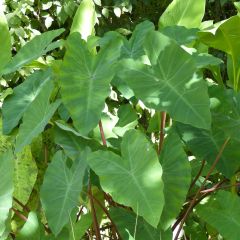
Colocasia esculenta - Elephant Ears
- Flowering time August, September
- Height at maturity 1,50 m
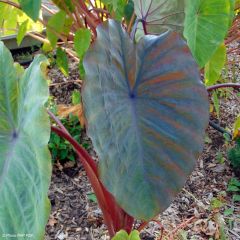
Colocasia esculenta Sangria
- Height at maturity 1,25 m
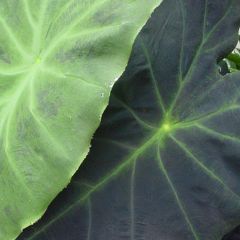
Colocasia Dragon Heart Gigantes - Elephants Ear
- Flowering time August, September
- Height at maturity 2 m
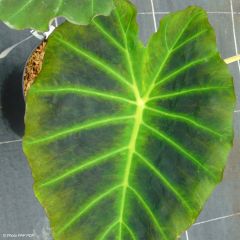
Colocasia Imperial Gigante - Elephants Ear
- Flowering time August, September
- Height at maturity 2 m
Discover other Colocasia
View all →Available in 2 sizes
Available in 2 sizes
Available in 1 sizes
Available in 2 sizes
Available in 1 sizes
Available in 3 sizes
Available in 1 sizes
Available in 1 sizes
Available in 1 sizes
Available in 2 sizes
Planting
Where to plant?
The ideal is to place the colocasia in light shade. Avoid placing it in scorching sunlight; it will appreciate some shade during the hottest hours of the afternoon. We also recommend planting it in a location sheltered from strong winds, which could damage the leaves.
The colocasia will thrive in moist soil, or at least in cool conditions. Don’t hesitate to plant the hardy varieties on the banks of a pond.
The substrate should be rich in humus and fertile. You can add some well-decomposed compost to the substrate before planting, and then apply fertiliser during the growing season.
Colocasia does not really like calcareous soils; it will prefer a slightly acidic substrate (with a pH between 5.5 and 7).
As colocasia enjoys warmth and is not always very hardy (unless you choose a variety like ‘Pink China’), it can be planted in a pot and grown indoors, in an apartment, greenhouse, or under a veranda, ideally with a temperature between 18 and 25 °C. Place it in a bright location but out of direct sunlight, which could scorch its foliage. The problem with indoor cultivation is that the air can sometimes be too dry. Therefore, it is advisable to use a humidifier to increase the humidity level in the air.
Even if you grow it outdoors, keeping it in a pot will allow you to bring it indoors for the winter, thus protecting it from the cold.
Colocasia is a large plant, so ensure there is enough space around it for proper growth. Keep in mind that it may cast some shade on nearby plants.
When to plant?
Colocasia is best planted in spring, after the last frosts, around April or May.
How to plant?
The sap of the colocasia can irritate the skin, so it is advisable to wear gloves when handling the plant.
- The plant can come in two forms: either directly in a pot or just as a tubercle. If it is in a pot, place the root ball in a basin filled with water.
- Work the soil to loosen it. Weeds should be removed, large clumps of soil broken up, and well-decomposed compost or leaf mould added.
- Dig a planting hole.
- Plant the tubercle 5 to 10 cm deep. If your plant is in a pot, remove the root ball and place it in the planting hole.
- Replace the soil and gently firm it down to ensure good contact between the substrate and the roots.
- Water generously.
We recommend applying a mulch around its base to help retain soil moisture for longer. Water regularly during the first few weeks while the plant settles in and develops its root system.
You can also plant your colocasia tubercle in a pot. Choose a sufficiently large container and plant in a mixture of garden soil, well-decomposed compost, and potting soil.
→ Learn more in our advice sheet: How to grow an Alocasia or Colocasia indoors?
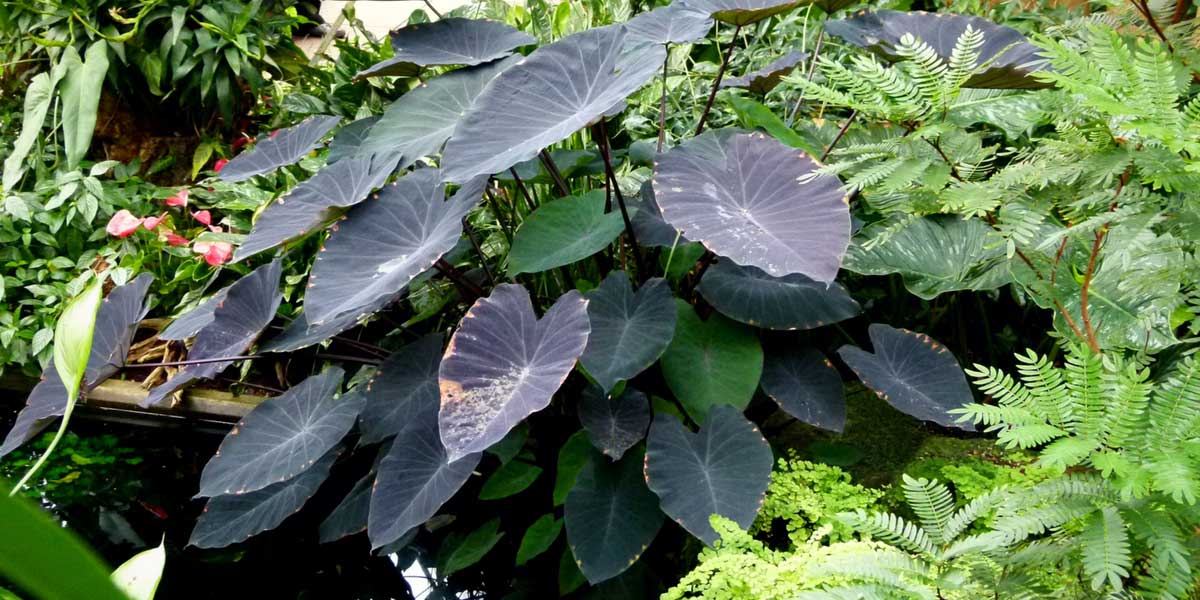
Colocasia ‘Black Magic’ (photo J. Rebel)
Care
Colocasia needs humidity, so ensure that the substrate remains moist. If the soil dries out for too long, the foliage may wilt. Feel free to water frequently during summer, preferably with non-calcareous water. Reduce watering (and fertiliser application) in winter.
Colocasia is quite a hungry plant: fertilise regularly during its growth. We recommend providing it with nitrogen-rich fertiliser every two to three weeks, especially if you are growing it in a pot; this will help it produce large, beautiful foliage.
Also, remember to repot your colocasias from time to time, ideally once a year, at the end of winter or the beginning of spring.
Wintering:
There are different techniques to protect colocasia from the cold in winter. It all depends on the region where you live and the hardiness of your variety.
If you are growing it outdoors in the ground, and it is a relatively hardy variety, you can simply apply a thick layer of mulch at the base to protect it from the cold.
If you live in a cold region, or if your colocasia is not very hardy, you can also dig up the tubers to bring them indoors. Cut the leaves about 2 cm above the tuber, then leave the tubers in the open air for at least a day to dry a bit. Store them in a dry place, in turf, sand, or sawdust. The temperature should not drop below 7°C, ideally keeping them between 10 and 15°C. Check the condition of the tubers from time to time. You can replant them in spring.
It is also possible to dig up the colocasia to temporarily plant it in a pot and bring it indoors for winter. You can then replant it in the ground in spring.
If you are growing your colocasia in a pot, simply bring it under a veranda, greenhouse, or inside your home, at a temperature between 10 and 15°C and in a bright location.
Diseases and pests:
Colocasia is a robust and vigorous plant, and it is relatively unaffected by diseases and pests. However, you may encounter problems with red spider mites, especially if the air is dry. You can avoid this issue by maintaining good humidity in the air by misting the foliage. Sometimes thrips may attack colocasia, small insects that pierce the tissues to extract the plant’s sap. It is also possible for slugs and snails to consume the leaves (especially in spring).
In winter, the tuber is susceptible to rotting, which is why it is important to reduce watering during this period or to store the tubers in a dry place.
Multiplication
Although it is possible to sow it, Colocasia primarily multiplies by dividing the tubers or taking offsets produced by the stolons. This will allow you to regenerate your plants.
Division of Tubers
Dividing helps prevent clumps from becoming too dense while regenerating your plants, and allows you to install them in another part of the garden. Colocasia sometimes produces small tubers alongside the main tuber. You simply need to separate them. This should be done at the end of winter, around March.
- Gently dig up the Colocasia by excavating around it if it is in the ground, or remove it from its pot.
- Remove some of the substrate to make the tubers clearly visible. You can rinse them under water if necessary.
- Divide by separating the tubers.
- Replant them in pots filled with potting soil and water.
Layering of Stolons
Like strawberries, Colocasia sometimes produces long stolons that run along the surface of the soil. These are horizontal stems that give rise to new clumps. You can easily separate them from the original plant and then replant the young shoots in pots or at a new location.
If you see these horizontal stems appearing, cover them with a little soil to allow them to root and develop a new seedling. Once it has several leaves, you can separate it from the mother plant by cutting the stolon that connects them. Replant in a pot and water.
Association
The best way to associate colocasia is to integrate it into an exotic garden, alongside other plants with lush foliage. For example, plant it with gunneras, tree ferns, banana plants, cordylines, or phormiums… and possibly with a few palms! For flowers, choose plants that offer large blooms in warm shades: canna, crocosmia, hedychium, watsonia, or kniphofia… You can add arums (Zantedeschia)… You will create a very exotic garden!
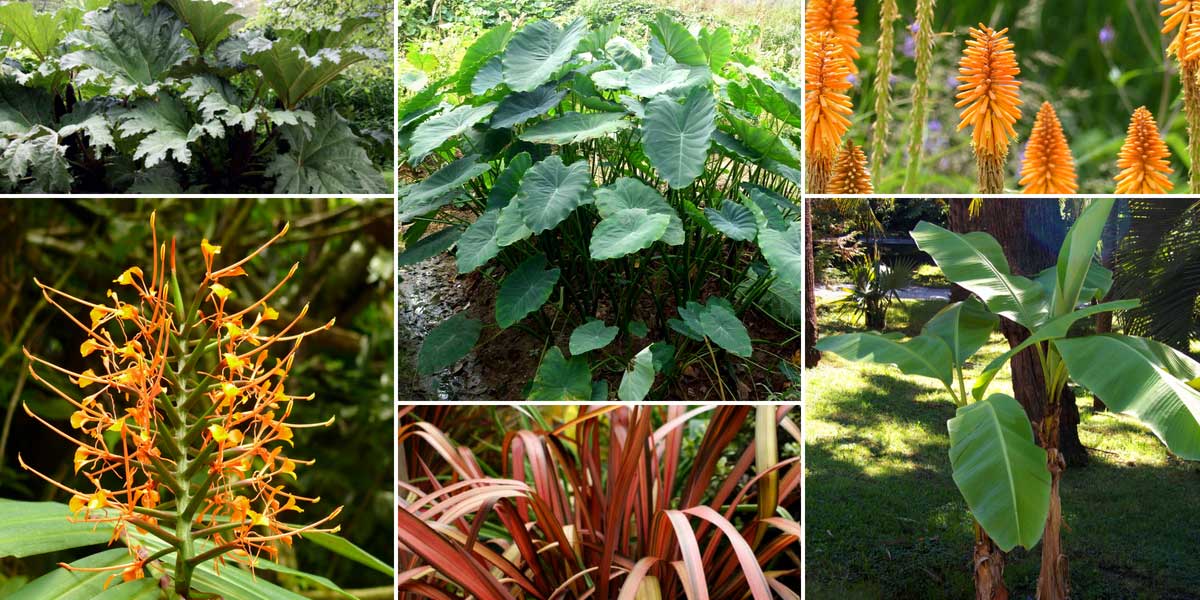
Colocasias are perfect in an exotic-style garden! Gunnera tinctoria (photo Drew Avery), Colocasia esculenta (photo Dalgial), Kniphofia ‘Fiery Fred’, Hedychium coccineum (Swati Sidhu), Phormium ‘Pink Panther’, and the banana plant Musa basjoo
As it is a plant that enjoys coolness and moist soils, do not hesitate to plant colocasia on the banks of a pond, with gunneras, ferns, Iris pseudacorus, or candelabra primroses… for a fresh and natural garden, ideal for recharging your batteries!
You can also create a beautiful summer scene with warm tones, particularly with summer bulbs, such as dahlias, gladioli, freesias, or lilies… generous and colourful blooms. Also enjoy the stunning blue flowering of agapanthus!
Colocasias offer leaves in various shades; you can therefore play with colours to create contrasts or special effects. For example, pair colocasias with almost black foliage (‘Black Magic’, ‘Dragon Heart Giant’…) alongside a few plants in the same tones, such as Sambucus ‘Black Lace’, Albizia ‘Summer Chocolate’, Cotinus coggygria ‘Royal Purple’, dark-leaved dahlias, or the grass Pennisetum setaceum ‘Rubrum’… However, do not overdo these shades, or you risk creating a visually “heavy” mass. The idea is rather to create contrasts. You can add bright, golden foliage, such as that of Hakonechloa macra ‘Aureola’, Physocarpus ‘Dart’s Gold’, or Lysimachia nummularia ‘Aurea’.
Colocasia can find its place in a warm greenhouse, alongside other exotic or tropical plants. It is also perfect in a patio, a courtyard, alongside ferns, hostas, bamboos, or Fatsia japonica… for a modern and graphic garden!
→ Discover more association ideas with Colocasia in our advice sheet!
Did you know?
- Taro, an edible plant
Cultivated in Asia for several thousand years, taro, Colocasia esculenta, has edible tubers once cooked (but toxic when raw!), which is actually how it got its species name, esculenta meaning edible. The tubers are particularly rich in starch and minerals (iron, calcium, vitamins…). They can sometimes be found in Asian grocery stores. The leaves can also be consumed after cooking. Care must be taken to cook it properly to avoid poisoning.
- Colocasia, Alocasia or Xanthosoma… What are the differences?
These three botanical genera are very close, to the point that they are often confused! In colocasias, the lamina of the leaf is generally directed towards the ground, whereas it is usually upright towards the sky in alocasias. Additionally, in both alocasias and colocasias, it is heart-shaped, while in xanthosomas, it is more sagittate, taking the shape of a leading shoot, with the two lobes at the base being quite pointed. Similarly, the petiole is connected to the leaf in a different way: in alocasia, it attaches to the edge of the lamina in a rather ordinary manner, so that the central vein is truly in line with the lamina, raising the leaf upwards. In colocasia, the petiole is attached to the leaf from underneath (peltate leaf), somewhat in the middle of the foliar surface, allowing it to angle and lean towards the ground.
- Hydrophobic leaves
The foliar lamina of colocasias has the particularity of being hydrophobic, like that of the lotus: water beads and slides off the leaf, and does not spread out! Thus, the foliage does not get really wet. Water droplets maintain a spherical shape and flow off, carrying dirt and dust with them…
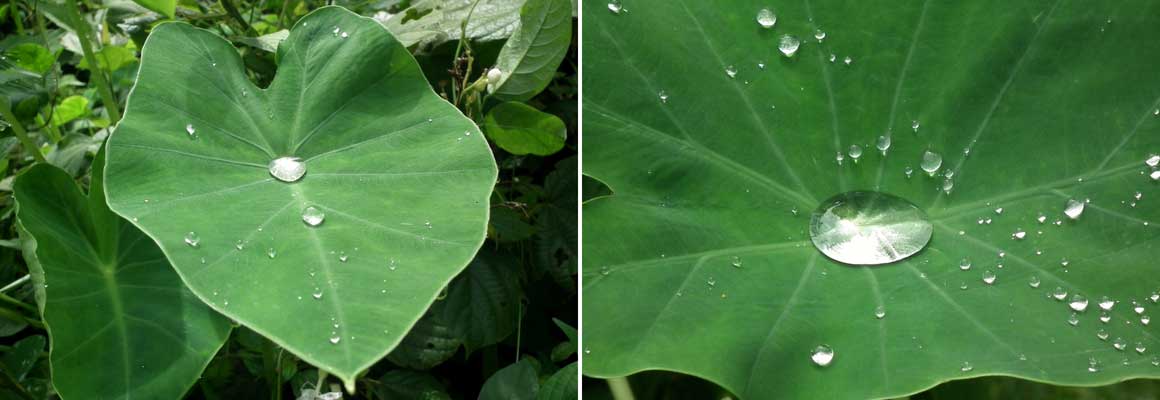
Water droplets slide off the colocasia leaves, without spreading and maintaining a spherical shape… (photo Rameshng)
Useful resources
- Discover our range of Colocasia!
- An article by Ingrid on our blog – 10 Exotic and Hardy Plants for Jungle Garden
- For more ideas and inspiration – Exotic Atmosphere
- Subscribe!
- Contents
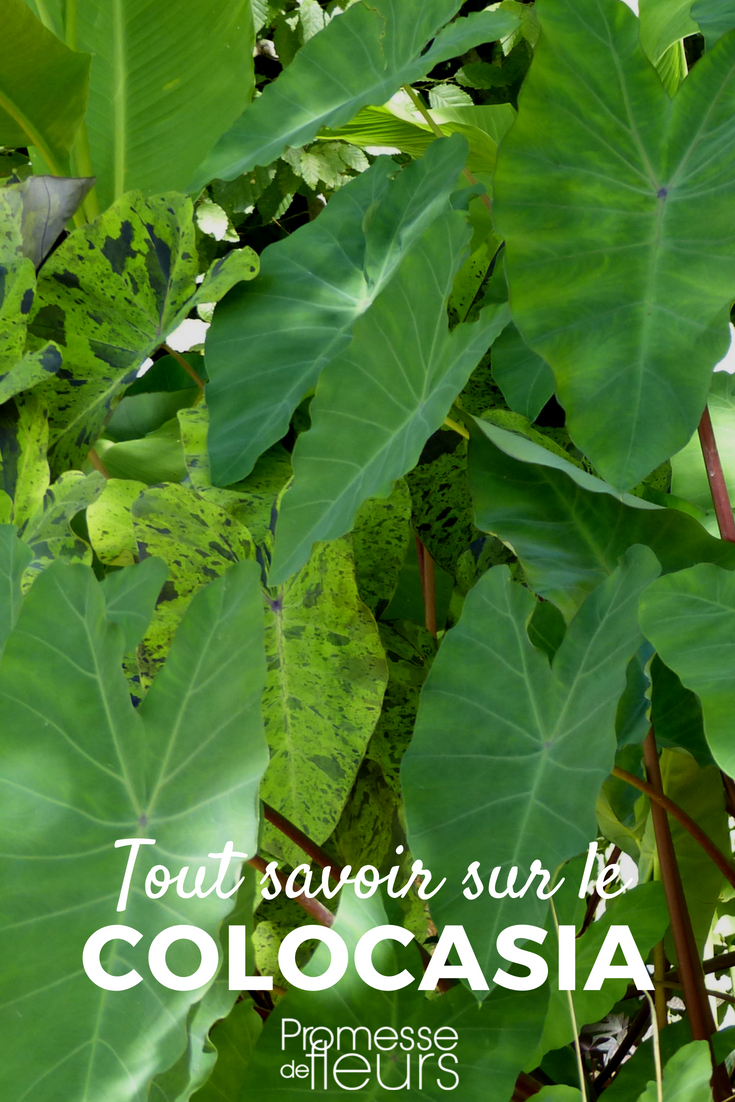































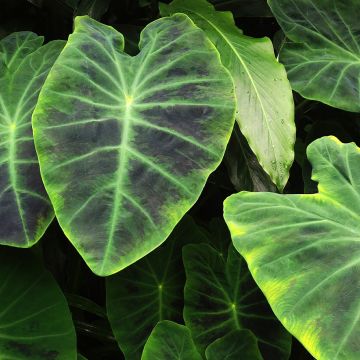

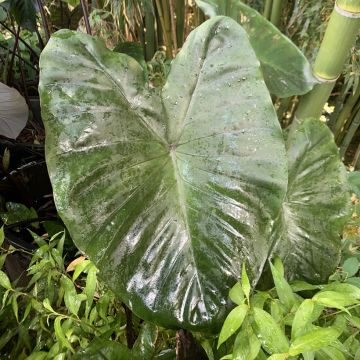






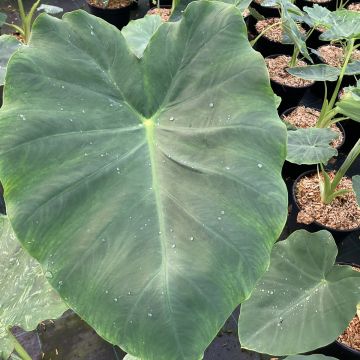
Comments